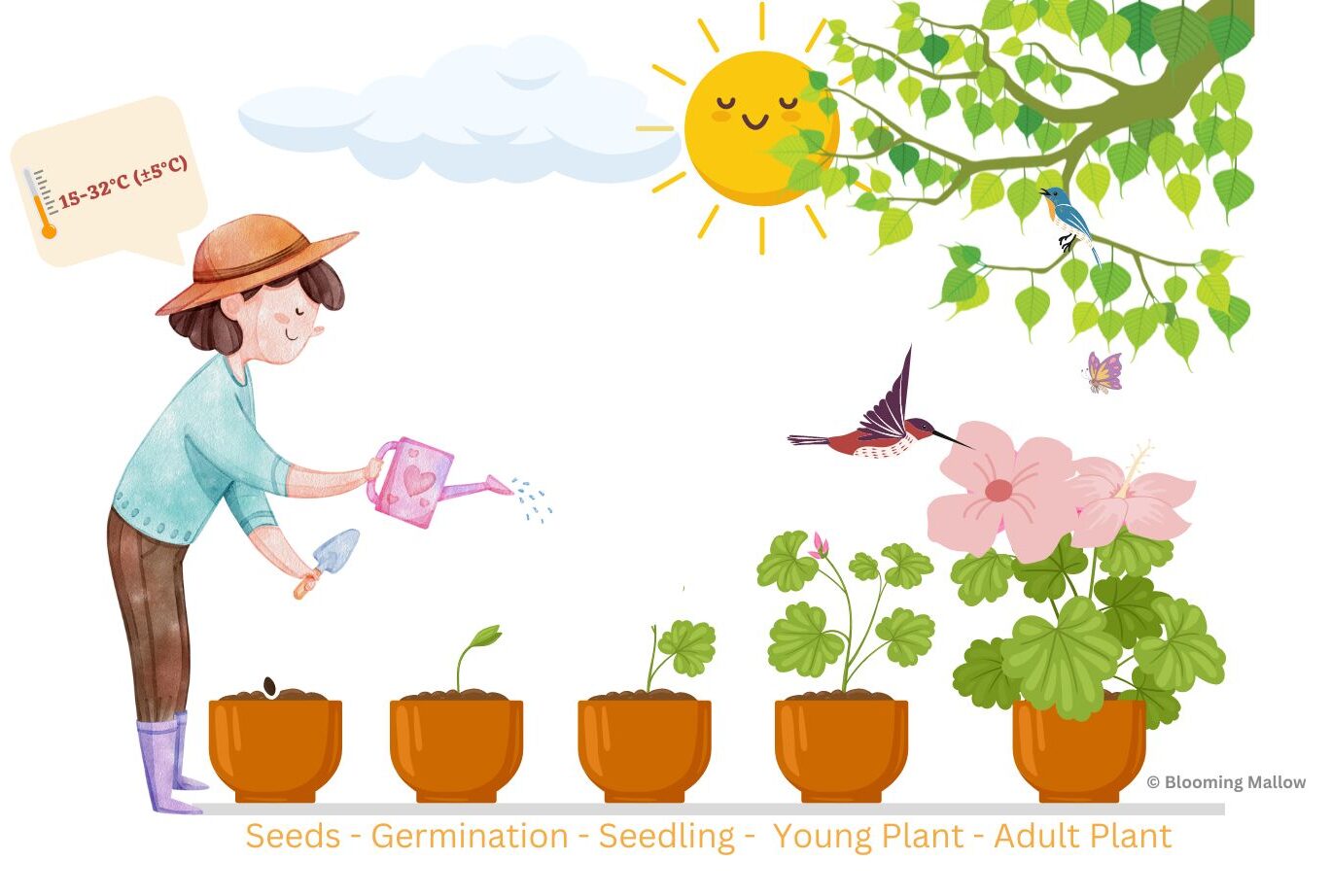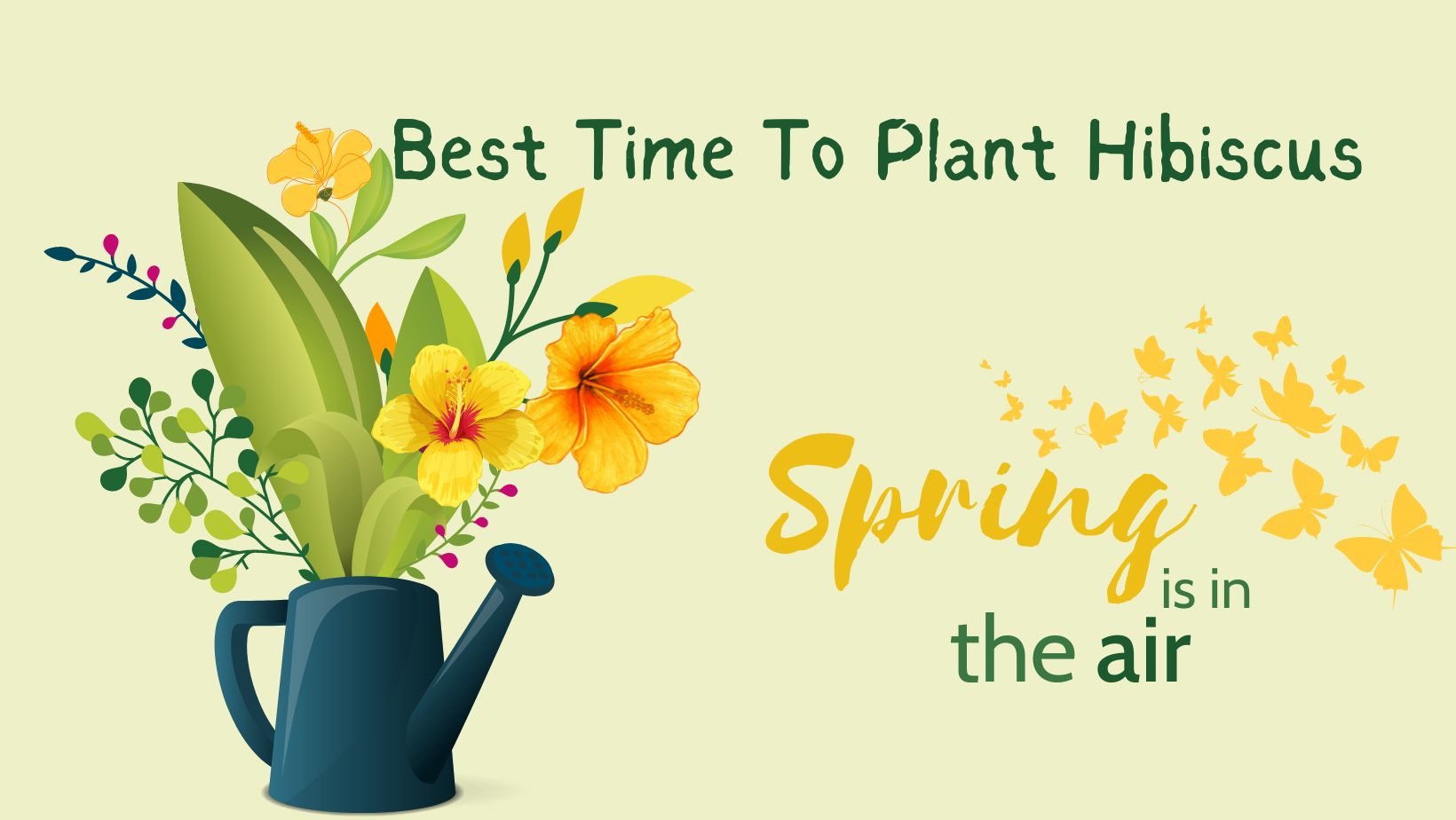
Hibiscus is widely appreciated around the world as a symbol of beauty and love, owing to its mesmerizing blooms. With its wide range of vibrant colors, including red, white, pink, orange, and yellow, hibiscus can add aesthetic value to any garden or indoor space.
However, growing these flowers can be challenging, as it requires consideration of prevailing weather conditions as well as temperature. This is why, in this blog post, I have listed the best time to plant hibiscus in every zone across the United States.
Overview

Hibiscus plants thrive in warm, sunny weather with temperatures ranging between 15°C to 32°C. They are sensitive to frost and cannot survive in freezing temperatures. So, they require a frost-free growing season for a long duration of time.
Why?
One of the reasons Hibiscus requires warm temperatures is because of its tropical origin (Asia). It is well-adapted to hot and humid conditions, which helps it grow and flower. This is the reason hibiscus also requires an ample amount of sunlight to thrive. They need at least 4-6 hours of direct sunlight every day to produce large, vibrant blooms. And if these conditions are not met, you are likely to see much-stunted growth and fewer buds.
How Does Climate Affect The Ideal Planting Season For Hibiscus?
Climate plays a crucial role in determining the ideal planting season for hibiscus. As already stated, Hibiscus thrives in warm temperatures and requires a frost-free growing season. Therefore, regions with mild winters and long summers provide the best conditions for hibiscus growth.
But the ideal planting season for hibiscus varies from region to region depending on the climate (i.e., the last frost date). Generally, hibiscus can be planted in the spring once you are sure that the temperature will start to rise and there is a minimal possibility of frost. However, in warmer regions like Hawaii, hibiscus can be planted year-round.
Excessive sunlight, on the other hand, can also affect hibiscus growth and flowering (such as in regions of Arizona). Moreover, high temperatures cause undue stress to the plant. Therefore, it’s essential to choose the right planting time based on the temperature conditions for optimal growth and blooming of hibiscus.
Suggested Reading- How Much Sunlight Does Hibiscus Need?
Hibiscus Planting Time Based On USDA Zones and States
| States | USDA Zone | Average First Frost Date | Average Last Frost Date | Best Time To Plant Hibiscus | |
|---|---|---|---|---|---|
| Alabama | 7a to 9a | November 1 | April 1 | After May 16 | |
| Alaska | 1a to 7a | August 15 | June 1 | After July 16 | |
| Arizona | 5a to 10b | November 15 | March 15 | After April 25 | |
| Arkansas | 6a to 8b | October 15 | April 15 | After May 30 | |
| California | 4a to 11a | November 15 | March 15 | After April 25 | |
| Colorado | 2a to 7b | October 1 | May 15 | After June 25 | |
| Connecticut | 5a to 7b | October 15 | April 15 | After May 30 | |
| Delaware | 7a to 8a | October 15 | April 15 | After May 30 | |
| Florida | 8a to 11a | December 15 | February 15 | After April 1 | |
| Georgia | 7b to 9b | October 15 | April 15 | After May 30 | |
| Hawaii | 10a to 11a | No Frost | No Frost | Anytime | |
| Idaho | 3a to 7b | September 15 | June 1 | After July 16 | |
| Illinois | 5a to 7a | October 15 | April 15 | After May 30 | |
| Indiana | 5a to 7b | October 15 | April 15 | After May 30 | |
| Iowa | 4a to 5b | October 15 | April 15 | After May 30 | |
| Kansas | 5a to 7a | October 15 | April 15 | After May 30 | |
| Kentucky | 6a to 7b | October 15 | April 15 | After May 30 | |
| Louisiana | 8a to 9a | November 15 | March 15 | After April 25 | |
| Maine | 3a to 6b | September 15 | June 1 | After July 16 | |
| Maryland | 6a to 8a | October 15 | April 15 | After May 30 | |
| Massachusetts | 5a to 7b | October 15 | April 15 | After May 30 | |
| Michigan | 4a to 6b | October 15 | May 1 | After June 15 | |
| Minnesota | 3a to 5b | September 15 | May 15 | After June 25 | |
| Mississippi | 7a to 9a | November 15 | March 15 | After April 25 | |
| Missouri | 5a to 7b | October 15 | April 15 | After May 30 | |
| Montana | 3a to 6b | September 15 | June 1 | After July 16 | |
| Nebraska | 4a to 6b | October 1 | May 15 | After June 25 | |
| Nevada | 4a to 9a | October 15 | April 15 | After May 30 | |
| New Hampshire | 3a to 6b | September 15 | June 1 | After July 16 | |
| New Jersey | 6a to 7b | October 15 | April 15 | After May 30 | |
| New Mexico | 4a to 8b | October 15 | April 15 | After May 30 | |
| New York | 3a to 7a | September 15 | June 1 | After July 16 | |
| North Carolina | 6a to 8b | October 15 | April 15 | After May 30 | |
| North Dakota | 3a to 5b | September 15 | June 1 | After July 16 | |
| Ohio | 5a to 6b | October 15 | April 15 | After May 30 | |
| Oklahoma | 6a to 8a | October 15 | April 15 | After May 30 | |
| Oregon | 4a to 9b | October 15 | May 1 | After June 15 | |
| Pennsylvania | 5a to 7a | October 15 | April 15 | After May 30 | |
| Rhode Island | 6a to 7b | October 15 | April 15 | After May 30 | |
| South Carolina | 7a to 9a | November 1 | April 15 | After May 30 | |
| South Dakota | 3a to 5b | September 15 | May 15 | After June 25 | |
| Tennessee | 6a to 7b | October 15 | April 15 | After May 30 | |
| Texas | 6a to 9b | November 15 | March 15 | After April 25 | |
| Utah | 4a to 8b | October 15 | May 1 | After June 15 | |
| Vermont | 3a to 5b | September 15 | June 1 | After July 16 | |
| Virginia | 6a to 8b | October 15 | April 15 | After May 30 | |
| Washington | 4a to 9b | November 1 | April 15 | After May 30 | |
| West Virginia | 5a to 7b | October 15 | April 15 | After May 30 | |
| Wisconsin | 3a to 5b | September 15 | May 15 | After June 25 | |
| Wyoming | 3a to 6a | September 15 | June 1 | After July 16 |
Should I Plant Hibiscus in Spring Or Autumn?
The recommended planting time for hibiscus is spring. This is because spring planting allows hibiscus to establish a strong rooting system before it is exposed to extreme summer temperatures.
By the same logic, it can be somewhat risky to plant hibiscus in autumn, especially if temperatures in your region drop below freezing very quickly. And since hibiscus is a frost-sensitive plant it will probably not survive in such conditions, even if you have planted a hardy variety.
In addition, hibiscus plants usually need some time to adapt themselves to the environment and may not flower in the first year. So, if you plant the hibiscus in the spring, they will have enough time to grow into a healthier perennial that will flower beautifully in subsequent years.
What Happens If You Plant Hibiscus In Wrong Season?
- Planting hibiscus at the wrong time of the year comes with some risks, including:
- Frost Damage: Hibiscus plants are sensitive to frost and cold temperatures. Planting hibiscus in late autumn or early winter can expose it to freezing temperatures, eventually killing it.
- Poor Flowering: Planting hibiscus at the wrong time of year can also lead to poor flowering. For instance, by planting Hibiscus in extreme summers, the plant will focus more on adapting to harsh conditions rather than blooming. And by the time it adapts itself, the weather changes again. Aside from this, planting at the wrong time of year can also slow down its growth.
- Increased Risk of Diseases: When planted at the wrong time, hibiscus plants become more susceptible to pests and diseases. This is because an unfavorable climate makes them prone to aphids and mealybugs that can even destroy their plant cycle.
- Stress: Choosing the wrong season for planting also results in undue stress to the plant. Again, this leads to stunted growth and poor flowering. The plant then struggles to adapt to the new environment initially, which can affect its ability to produce healthy seedpods in the future.
- Reduced Lifespan: Lastly, planting at the wrong time leads to reduced lifespan. The plant may not survive long enough to reach its full potential, thus wasting the resources, time, and money you invested in it to grow.
That is all I wanted to share in this post. If you are looking to expand your hibiscus garden, you can learn to propagate hibiscus from cuttings with my easy-to-follow guide.
Happy gardening!




